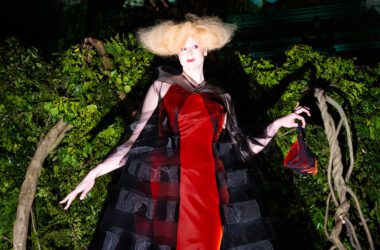[ad_1]
Autocracy may be much in the news, and increasingly in vogue depending on the electorate, but as Milan Fashion Week began, democracy was in the air. At least so it was at Diesel where, in a preview, the designer Glenn Martens was touting “transparency without censorship.”
Sounds pointed, but what he meant was tearing down the fourth wall, allowing anyone to access a live feed starting 72 hours before his show to watch the process of creation via cameras trained round-the-clock on the atelier, the casting area, hair and makeup, and so on. Then 1,000 viewers signed up to sit “front row” from home, their faces live-streamed on screens all around the show venue, so as they were watching the audience and the models on the catwalk, the audience and the models were watching back.
So the crowd at the show could see, for example, the viewer who decided to disguise themselves using an alien filter, resembling a creature from “War of the Worlds,” or the viewer who situated her generous cleavage right in the middle of the screen, or the ones who watched with family members, or their dogs. So the show crowd would be reminded, in other words, of the people it was really all about.
Fashion, in essence the most dictatorial of disciplines, where designers traditionally handed down styles like edicts from on high, has been theoretically democratizing for awhile now — ever since it jumped from the salon to the store via ready-to-wear, which changed the barriers to entry from class and caste to pocketbook.
Then came fast fashion, lowering that wall, and then social media opened the door even further, allowing everyone to see a show and pass judgment on it without being dependent on the industry’s power brokers to decide what they knew and when they knew it.
But while designers have thrown their shows open to the public before (Diesel did it last season, when Mr. Martens held a giant rave-as-a-show), and made their audience a part of the experience (see Balenciaga’s red carpet collection), thus far no designer had offered unfettered behind-the-scenes access. There was always a sense that some sort of mystery had to be preserved, some relic of the us-and-them relationship. Not any more.
“For me it’s quite important that we always remember that actually 95 percent of our customers are people who are not the happy few editors, buyers, influencers and celebrities,” Mr. Martens said in the preview.
It’s a fair point, but what made his show special wasn’t really the fact it was subverting the elitism of the event itself.
It was the fact Mr. Martens was also using materials to subvert the basic meaning of beauty and luxury; taking “transparency” from accessibility to design experiment. (In this, he is like Balenciaga’s Demna, who is also interested in upending hierarchies of taste). Diesel may be a denim brand, but Mr. Martens has transformed it into a high-concept laboratory — the sort of curtain-raising show that is a magnet for fashion purists who vote for pushing the edge of what can be done with clothes.
He has essentially taken the idea of devoré — the process in which chemicals are used to dissolve cellulose material, so fabrics look eaten away or corroded, and which is traditionally used on velvet — and figured out a way to apply it to a variety of textiles. So dresses and shirts in jersey made to look like denim or cotton or plaid seemed as if patches of the fabric itself had been sweated away to reveal the skin beneath. And florals, tulle and leopard print were desiccated to resemble either lace or scrap, depending on the angle, depending on how you saw them.
Mr. Martens isn’t interested in preserving the iconography of empire. Leave that to Fendi, where the designer Kim Jones reproduced the historic statues outside the brand’s Roman headquarters onto knits and sheer organza, sculptures on cloth that led him to make sculptures in cloth, rounding shoulders and curves, carving cable knits. Or to Roberto Cavalli, where Fausto Puglisi offered up 54 variations on Carrara marble.
Rather, Mr. Martens is interested in exploding the clichés of the bourgeoisie (and people’s expectations of Diesel).
Everything you thought you recognized turned out to be something else. Faux fur trapped under mesh to look like feathers; knitwear boiled and matted so it looked more like yak fur than mohair; and denim treated to look like leather. Puffer jackets were quilted in argyle patterns that were then splashed with paint to frame a peekaboo covering so the stuffing inside, which looked sort of like an orange cauliflower, became the star.
That made for complicated, challenging fashion. Mr. Martens’ genius was in packaging it as a bit of current affairs rebellion, the better to lure everyone in. Either way, it was a reminder that the real mystery isn’t how you make a show. The mystery is how you make the clothes. And that, magically, remains.
Source link









